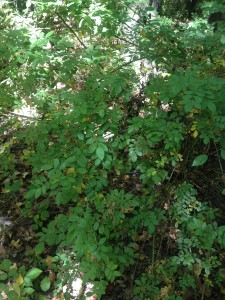1a. A member of the Asteraceae with an explanation of the characters that you used to determine the family identification.
The inflorescence of Asteraceae is distinctive. Has a prominent head, a cluster of flowers that appear to be a single flower.
Specimen: Goldenrod (Solidago sp.)
Location of specimen: Mt. Sterling, OH
.
1b. A member of the Poaceae with an explanation of the characters that you used to determine the family identification.
Field Corn (Zea sp.) is a member of the Poaceae family because the fruit is a caryopsis (the seed coat of a corn kernel is fused to the fruit wall). This family has leaves with entire margins and parallel venation. Other characters include: hollow stems, and open leaf sheaths. Location of specimen: Mt. Sterling, OH
2a. Multiflora rose (Rosa multiflora)
Shrub. Compound leaves with 5-9 leaflets and feathered stipules. Other ID characters include reddish/purple hips and stout prickles. Location of specimen: Waterman Farm, OSU.
2b. Indian grass (Sorghastrum nutans)
The base of the leaf has a “rabbit ears” structure. Leaves with entire margins and parallel venation. Other ID characters include: hollow stems, and open leaf sheaths. Location of specimen: OSU
3a. A plant with ovate leaves:
Ovate: a leaf with the shape of an egg.
Specmien: Tri colored beech (Fagus sylvatica ‘Roseo-marginata’)
Location of specimen: Upper Arlington, OH
.
3b. A plant with a gynoecium composed of five carpels
Gynoceium: The female structures of a flower, collectively.
Carpel: The innermost whorl of a flower
Specimen: Geranium (Geranium sp.)
Location of specimen: Upper Arlington, OH










The pictures of the corn are quite mesmerizing. They really take into account the transition from bright, flowery summer to cold, stagnant autumn. Great work! I was previously unaware of any shrubs that had prickles on them. Next time I’m clearing out shrub from my garden I’ll be aware!
I like your picture of the ovate leaf. You can also tell that leaves have acute apices.